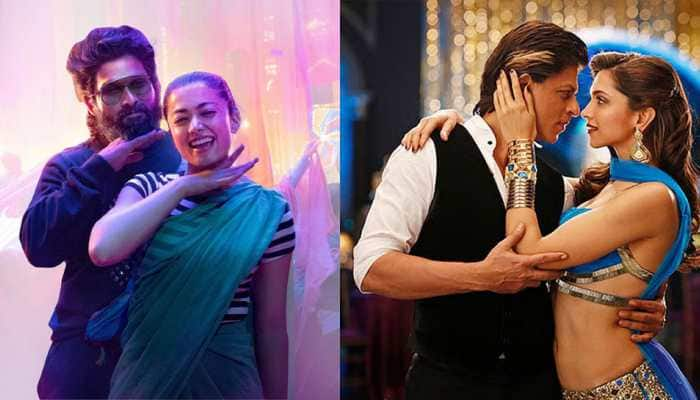The Sultry Sanskari: Sridevi’s iconic screen persona merged the heroine and the vamp
A premature death at 54 is not one would have wished for her, but one look at her filmography in Hindi and four southern languages show that she had packed more into her life and career in those years than many of us would perhaps wish in lifetimes.
Trending Photos
)
I confess I am not a major Sridevi fan or follower, but it speaks volumes of her achievements when I look back to see how I was casually interacting with her long and illustrious career time and again and how significant she was thus to emerging India’s culture. A premature death at 54 is not one would have wished for her, but one look at her filmography in Hindi and four southern languages show that she had packed more into her life and career in those years than many of us would perhaps wish in lifetimes.
But beyond her acting capabilities, her versatility and her earning the title of Bollywood’s first female superstar lies something that is largely uncelebrated. Her role as an icon whose screen persona in the most successful years of her long career marked a milestone in the image of the modern Indian woman, as someone whose characters ushered in a new kind of personality in the country’s popular imagination. More on that later.
My first brush with Sridevi was as a schoolboy vacationing with grandparents in Thiruvananthapuram, then Trivandrum. We came back excited by a mythology-mixed family thriller Thunaivan in which the most exciting scenes involved the young Lord Murugan (Balamurugan), played by one “Baby Sridevi.” The cherubic, enchanting child role turns out to be her debut film.
The second big brush was a few years later in a Tamil Nadu small town in a movie I could not see because I was not old enough. This “Adults Only” Malayalam film by I.V.Sasi was Aalinganam (1976) – and if the official information is any indication, she acted in this movie when she was only 13. We may want to separately debate her real age later, but more important, she had arrived as a “heroine” across the Vindhyas.
Some five years later, as a young trainee inThe Times of India newsroom in Mumbai (then Bombay), I got a perk of sorts when celebrity film critic Khalid Mohamed asked me if I wanted to see with him the Friday first-day-first-show of the movie he was due to review for that week. I eagerly tagged along to see what turned out to be a milestone movie: “Himmatwala”. It was also probably the ushering in of a potboiler genre that earned Sridevi the dubious sobriquet: Thunder Thighs.
Khalid’s review was acerbic and hilarious. His critical reviews were works of art that often tore down the big banners of Bollywood. The kind of films Sridevi was beginning to get famous for was just the kind he would love to get his acid-dripped pen into. We laughed in the newsroom while the producers who put their money on Sridevi were laughing their way to the banks.
A star was born.
It was here that an icon was being shaped, slowly but steadily, an icon who would bring home a bolder sexuality to India’s traditional or working-class homes. As movie after movie turned hit at the box office, Sridevi was hot property, and those in the company of Jeetendra with dialogues by Kader Khan were the most celebrated of them all. Here is where the iconic Sridevi was shaping up, even as she acted in critically acclaimed roles elsewhere.
Her role as a mentally challenged girl in MoondramPirai (Tamil, 1982), remade as Sadma (Hindi, 1983) was a far cry from her role in Meendum Kokila (Tamil, 1981), in which she plays a Tamil Brahmin housewife clad in a nine-yard traditional saree. Somewhere along the way she had played a gawkish teenager in Pathinaru Vayathinile (Tamil, 1977) remade as Solva Sawan (Hindi, 1979). In 1986, she played a supernatural snake-woman in Nagina. Older roles came later in English Vinglish (2012). What a range!
But Sridevi the icon was steadily out-running Sridevi the actress. In the drawing rooms of genteel, upper class India, the double-meaning dialogues of Kader Khan and the oomphy gyrations of Sridevi were stuff of scandalous conversations. If Thunder Thighs was a favourite Bollywood gossip column descriptor for Sridevi, Jeetendra, with his patent white leather shoes and trousers was ‘Jumping Jack” to go with her.
Sridevi’s exhaustive filmography reveals she had ten releases in Hindi alone in 1986 and six in 1987.
Now, ask yourself a question: If she was Bollywood’s first female superstar, and Amitabh Bachchan was the male superstar of those times known for his iconic “Angry Young Man” roles, what title would you give the iconic Sridevi? Fact is, she was, like Bachchan, a versatile actor but unlike him, she only got the uncharitable “Thunder Thighs” sobriquet – maybe because it was and is still a male-dominated world.
This was a period when I decided to study the iconography of Sridevi. Encouraged by veteran film theorist, critic, mentor and friend Anil Saari Arora I decided to actually see one of those hits frowned upon in genteel drawing rooms. I bought myself a cheap morning show ticket at the now-defunct Stadium Cinema, where I experienced Sridevi, the icon.
I don’t quite recall the name of the film now. Was it Aulad or Ghar Sansar or Suhagan? It doesn’t really matter perhaps but the cackles and the catcalls at Stadium Cinema gave me an idea of the superhit genre. The notable feature was that Sridevi in many of these movies played characters that broke the traditional barrier between the traditional Bharatiya Nari and /or the Abla Nari (Damsel in Distress) and the oomphy vamp.
I went on to write a piece that compared Sridevi with Zeenat Aman of the 1970s. Here was a persona who could dress in revealing clothes, be comfortable in her sexuality and yet be a responsible, caring Indian woman. But she represented sexual liberation within the folds of a traditional Indian family, within the feudal-patriarchal fold, and yet representing in some ways the imagery of the urban, Westernised Zeenat Aman or Parveen Babi a decade earlier. She was the working-class icon who blended traditional conservatism and latter-day sexuality with ease.
Looking back, if Le Bachchan was the “Angry Young Man” I would call Sridevi as the "Sultry Sanskari" – and not the pejorative "Thunder Thighs" as she was then often referred to. Later movies including Chandni (1989) and Lamhe (1991) confirmed the arrival of an icon who would be coy, feminine and traditional, wearing red-banglechooris and bindi and yet be comfortable as a sex symbol.
To truly understand this title, you have to back to the 1950s and 1960s. On-screen roles in those times only had two extremes. Either you had the suffering Sati-Savitris or Mother India types who played dutiful daughters, daughters-in-laws or wives or you had the village belles or glamorous dolls. If Nargis, Meena Kumari and Nutan typically played suffering Savitris, the likes of Asha Parekh, Saira Banu or Babita played the dolls. Actors like Mala Sinha and Nanda enjoyed only moderate success in the middle. For anything boldly sexual those days, the movies had a vamp, played by the likes of Nadira, Shashikala and Helen. If you were looking for sexual gyrations and revealing clothes, only the vamps could do it. An occasional bikini scene like the one in Sangam featuring Vyjayanthimala was just a flash in the pan.
Things changed in the 1970s when Zeenat Aman and Parveen Babi broke the barrier between the heroine and the vamp. Bolder sexuality became mainstream in the Bollywood narrative for the well-heeled middle class but that was rarely to be seen beyond Delhi and Bombay. Sridevi, as the Sultry Sanskari, pretty much did that in the 1980s for the working class and made it a national phenomenon.
It is noteworthy that the term Sanskari had not yet become part of the cultural vocabulary of modern India. It was only the Ekta Kapoor-made TV serials of the 1990s and Alok Nath playing the traditional patriarch in them that made popular the term “Sanskari’ (a reference to the traditional, culturally rooted person).
The sexy vamps seemed to vanish with the arrival of Zeenat Aman in the 1970s and then were certainly not needed when you had Sridevi or a Jayaprada in the 1980s. Madhuri Dixit confirmed this trend with the movie Beta (1992) with her hit song Dhak Dhak Karne Laga even though her role was of Saraswati who plays a devoted wife. But long before that, in 1983, Sridevi had gyrated to Naino Mei Sapna.
The old Mother India was by now a faint memory. The Sultry Sanskari had arrived.
(Madhavan Narayanan is a senior journalist who has covered politics, diplomacy, business, technology and other subjects in a long career that has spanned organisations including Reuters, Business Standard and Hindustan Times. He is currently an independent columnist, editor and commentator. He is listed among the top 200 Indian influencers on Twitter. He tweets as @madversity)
(Disclaimer: The opinions expressed above are the personal views of the author and do not reflect the views of ZMCL)
Stay informed on all the latest news, real-time breaking news updates, and follow all the important headlines in india news and world News on Zee News.
Live Tv







)
)
)
)
)
)
)
)
)
)
